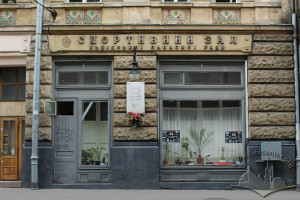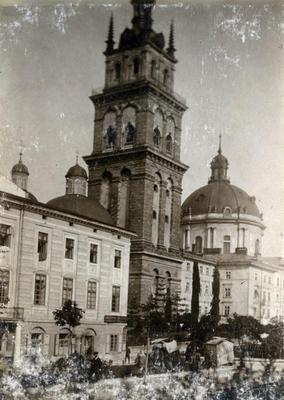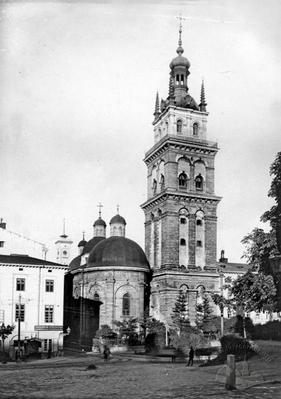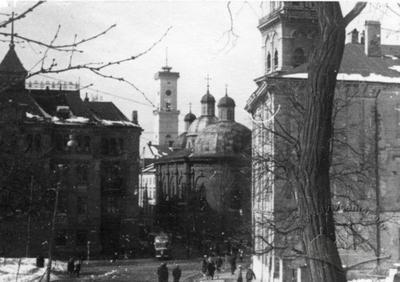Vul. Ruska, 20 – First Municipal Polyclinic (former Dnister Insurance Company Building) ID: 372
The four-storied building on the corner of Ruska and Pidvalna streets was built in 1905-1906 under a project designed by architects Ivan Levynskyi (Jan Lewiński) and Tadeusz Obmiński. The building is one of the best and brightest examples of the "Hutsul" Secession in Ukraine; it is an architectural monument (protection number 391). The Dnister company played a quite remarkable and symbolic role in the cultural life of the Ukrainian community in the early 20th c. Today the building is occupied by the First municipal clinic.
Story
The building is located in the central part of the city, on the corner of Ruska and Pidvalna streets. Previously, it was there that the “High wall” ran, which was the first line of the city fortifications built in the late 14th c. Nearby, the so-called "bosatska" (“barefoot men’s”) wicket was located, named so due to the monastery of the Discalced Carmelites situated on the hill opposite it (now Vynnychenka street 22). From inside the town, residential houses stood closely adjacent to the wall; on one side, it was the former Jewish district situated between what is now Ruska, Arsenalna, Brativ Rohatyntsiv and Serbska streets, while on another side it was Ruska street where Ukrainian (Ruthenian) population of the town was concentrated.
After the Lviv fortifications were dismantled in the second half of the 18th c., a townhouse was built there forming a new housing red line on Pidvalna street. This house existed for over a century. In 1871 it belonged to Ezriel Salamon Meller, a Jewish merchant (Skorowidz, 1871). It was a residential building; the ground floor premises were rented out to various tenants, including the Ukrainian sports society Sokil.
In the early 20th c. the plots located at the corner of Pidvalna and Ruska streets were bought by the Ukrainian insurance company Dnister. In 1904 the company declared an architectural competition for the construction of a new office and residential building there. The first prize was won by architect Alfred Zachariewicz, but his project was not implemented. Instead, the house was built under a project designed at Ivan Levynskyi's (Jan Lewiński) architectural bureau (Бірюльов, 2008, 418). Their first project made in 1904, which was also submitted to the contest, involved the dismantling of only three townhouses, thus preserving the old configuration of Ruska street (DALO 2/2/3807). However, the project was redesigned. It was finally approved by the Lviv Magistrate on 23 July 1905 (DALO 2/1/3806). Under this project, the whole eastern part of Ruska street was extended. With this in view, all buildings on its southern side were dismantled, including those designated by numbers from 241 to 249. In their place, modern townhouses were built (Ruska street 16, 18, 20). Houses 16 and 18 are designed in the Historicist style while house 20 belongs to the "Hutsul" Secession style, one of the Art Nouveau trends.
As a result of these changes, the housing red line of Ruska street was shifted by 4.8 m to the middle of the block while that of Ivana Fedorova street was shifted by 2.9 m (DALO, 2/2/3802: 79-80, 2/2/3803: 89-90).
The house number 20 on Ruska street was built in 1905-1906. Its façades were designed by architect Tadeusz Obmiński; the graphical solution of the ceramic decoration was developed by Oleksandr Lushpynsky under the artistic direction of Osyp Biloskurskyi (the Prosvita Society calendar, 1907, 88-89). All artistic metal details of the façades (entrance doors, tower and balcony gratings) were produced at the locksmithery of Mykhaylo Stefanivskyi. The construction was managed by Filemon Levynskyi (DALO 2/2/3806). The Dnister company building, richly decorated with ceramics bearing ethnic motifs patterns, moulding, and metal, with its peaked roofs resembling Boyko churches, was the gem of the "Hutsul" Secession style both in Lviv and in whole Ukraine. In addition, the building played an important symbolic role, being the center of the city’s Ukrainian culture, a meeting place for the Ukrainian community.
The building was constructed for the Dnister insurance company; some other Ukrainian unions and organizations had their offices there too. The ground floor was intended for other public functions, such as trade, sports, and food service. The building is divided in plan into two clearly distinguishable blocks, each having a courtyard and a separate entrance, one from Ruska street (block A), while the other from Pidvalna street (block B). According to archival documents, the house had two addresses: Ruska street 20 and Pidvalna street 7 (DALO, 2/1/3806: 89). Its west part (Ruska street 20) was occupied by the company offices and by other organizations; apartments for some representatives of the Ukrainian intelligentsia were located in the part facing Pidvalna street. The apartments were occupied by some well-known Lvivites of Ukrainian origin, including the chairman of the State Secretariat (Government) of the Western Ukrainian Peoples’ Republic Kost’ Levytskyi; Ivan Berezhnytskyi, a dentist well-known throughout Galicia; Osyp Nazaruk, a politician and a public figure, and some others (Ilko Lemko, Lvivska Hazeta, № 32, 2007; Ukrainian daily Svoboda, 1965, 1). It is known that there was an art market in the building’s larger courtyard. The gymnasium situated on the ground floor was occupied by the Ukrainian sports society Sokil. The Ruska Besida theater staged their performances in this gymnasium more than once; besides, it was there that the future stage director and actor Les Kurbas appeared on stage for the first time as a member of an amateur student theater in 1909. Apart from that, a part of the ground floor premises was occupied by a small shop selling products of the Ukrainian confectionery factory Fortuna Nova which existed until 1939. For a short time, the restaurant Fuchsa functioned in the house (Ilko Lemko, Lvivska Hazeta, 60, 2007; DALO 2 / 2/3806: 93). An interesting feature of the project was that it provided the possibility of extending offices at the expense of residential premises, if necessary.
In the 1950s, after the Second World War, the building was deprived of nearly all its original features. The hostel number 1 of the Regional Soviet Party School of the Communist Party regional committee was located there, as well as a cafeteria, the Lviv regional council’s gymnasium, a shoe repair shop and the bathhouse number 5. Now the building is occupied by the First municipal clinic; some parts of the ground floor are also occupied by an Oshchadbank office, a binding shop, a pharmacy, and a gymnasium.
There are no records of any reconstruction of the building. In 2006 a restoration of the small wooden tower was carried out and a part of the roofing was replaced.
Architecture
The four-storied corner building, designed in the "Hutsul" Secession style, is located in the central part of the city and is surrounded by dense historic housing. The building is well discernible from Pidvalna, Vynnychenka, and Prosvity streets, its peaked roofs with a richly decorated small wooden tower clearly distinguished in the panorama of the city.
The building is complex and asymmetric in plan. Theoretically, it can be divided into two parts, each having its own entrance and courtyard. As it was mentioned above, according to the project, one of the parts (block A) was meant for various public functions, while the other (block B) was reserved for housing. Currently the house is divided into two parts only in terms of its composition and not functionally.
The block A is rectangular in plan, with stepped projections on its south side. The house can be entered through an entry gate and a passage connecting Ruska street and the courtyard. The main part of the building and the gymnasium with its utility premises can be entered from the passage. In the courtyard, there are also entrances leading to the premises now occupied by the binding shop, pharmacy, etc., as well as another entrance to the main part of the building. There is a passage to the block B’s courtyard there too.
The main staircase is grouped with the corridors running around the courtyard; the corridors are very well lit due to the fact. At the east side, which is adjacent to the block A, there is also a corridor lit from the block B’s courtyard. All the other premises are located chiefly on the building’s perimeter; that is why their windows are located on the street façades. Under the project, a lot of premises were large enough, but at the moment they are probably divided by additional partitions to create more medical offices.
The block B has the shape of a trapezoid with stepped projections on its east side. From the same side, on the central axis of the façade, an entrance to the block B was designed, which is not used currently. The Oshchadbank office, located in the northeast corner of the building’s ground floor, has a separate entrance. There is also a pharmacy on the ground floor, which, however, can be entered from the north side of the block A. The staircase and corridors are grouped near the east wall of the courtyard, and that is why they are provided with adequate lighting. The staircase can be entered from the courtyard. Incidentally, such a grouping of the courtyards and the horizontal communications of the two blocks enables one to quickly move from the block A to the block B and vice versa, thus creating a relatively single communication space.
Under the project, there were two apartments on each of the second, third, and fourth floor, a six-room one and a four-room one. The apartment’s basic living rooms, except kitchen, are located on the perimeter of the building so that their windows overlook the street. The kitchen windows in both apartments face the courtyard. Utility premises (bathrooms, toilets, pantries, internal stairs, tambours) are also located near the walls of the courtyard. Currently the block B is used as a part of the First municipal clinic; that is why virtually all the rooms have lost their original purpose.
The building’s walls are made of brick, its socle is lined with sandstone blocks while the foundation probably sits on reinforced concrete cushions. Decorative moulding elements on the façades are made of Roman cement. A small tower from the side of Pidvalna street is wooden. The balcony fencing and the railing on the roof and on the gate are made of forged metal.
The building’s mustard-yellow street façades are richly decorated. The ground floor is revetted with massive rustication. In a special way the house is embellished with decorative bars made of ornamented ceramic tiles and with ceramic tile inserts in window trimmings and in recessed panels under the windows. In tile ornaments one can see white, green, and red colours, which are very typical motifs of Ukrainian folk embroidery. Due to this rhythmic structure of the façade’s colour and texture areas, as well as due to active silhouettes of the frontons and of the tower, the house is very expressive and well perceived from the distance. The building has curved attics and peaked roofs, reminiscent of Carpathian churches. On the attics, there are inscriptions in old Cyrillic alphabet "АЦЕ" which means the date when the construction was started – "1905" . The top floor’s stylized Neo-Roman blind arcade complements typical Secession elements in a peculiar way. Forged balcony railings and entrance gates are in harmony with the façade décor. Above the main entrance from Ruska street, there is a slab with the following carved inscription: «Товариство страховихъ обєзпеченъ Дністеръ». The smooth façades of the courtyards have no relief decoration; there are decorative elements made of ceramic tiles in the larger courtyard.
The building’s interior space is designed in the same style, with the use of Hutsul motifs. Some of the premises, particularly vestibules and halls, have retained their authentic interiors. The authentic ceramic tile flooring, moulding on the walls and ceilings, the décor of the pillars and columns, forged railings of the staircases have been preserved. All elements are successfully combined with each other and with the style of the building as a whole. The only exception is the ceiling painting, which depicts twining plants and flowers (painter Teodor Heleta), on the side staircase’s vault, as its style is close to the ornamentation typical of the Western European Art Nouveau (Biriuliov, 2008, 419).
Related buildings and spaces
People
Tadeusz Obmiński (1874-1932) – a
Ukrainian and Polish architect and teacher.
Osyp Biloskurskyi (1883-1943) – a
Ukrainian ceramic artist.
Filemon Levitskyi (1873-1922) – a
Ukrainian architect and constructor.
Alfred Władysław Zachariewicz
(1871-1937) – a Polish and Ukrainian architect, painter and entrepreneur.
Kost’ Levytsky (Kost' Łewycki; 1859-1941) – one of the most prominent political
and public figures of Galicia.
Les’ Kurbas (Oleksandr-Zenon Kurbas;
1887-1937) – a Ukrainian stage director, actor, theater theorist,
playwright, essayist, translator; People's Artist of the USSR (1925).
Ivan Berezhnytskyi – a dentist,
famous throughout Galicia, who lived on Pidvalna street 7 (now Ruska 20).
Leontiy Maksymon’ko (1893-1965) – a doctor-ophthalmologist
who lived on Pidvalna street 7 (now Ruska 20).
Osyp Nazaruk (1883-1940) – a
Ukrainian public and political figure, writer, journalist and publicist.
Teofil Berezhnytskyi (1836-1895) – a
Ukrainian judge, lawyer, public figure, co-founder of the Dnister insurance company.
Vasyl Nahirnyi (1848-1921) – a
Galician architect and public figure, co-founder of the Dnister insurance company.
Demian Savchak (1847-1912) – a
Ukrainian public figure, lawyer, co-founder of the Dnister insurance company.
Sources
- Державний архів Львівської області (ДАЛО) 2/ 2/ 3806;
- Науково-технічний архів Науково-реставраційного проектного інституту "Укрзахідпроектреставрація", Опрацювання проектних пропозицій по формуванню історико-культурного осередку у пішохідній зоні вул. Руської у м. Львові, т. 1, кн. 2, (Львів, 1988);
- Науково-технічний архів Науково-реставраційного проектного інституту "Укрзахідпроектреставрація", Обміри фрагментів фасадів споруди колишнього товариства "Дністер", пам’ятки поч. XX ст. на вул. Руській, 20, (Львів, 1996).
- Ілюстрований народний календар товариства "Просьвіта" на рік звичайний 1907, "Нові рускі будинки", (Львів, 1907);
- Ілько Лемко, Львівська газета, 2007, №32 (102), 23 лютого 2007 р.
- Ілько Лемко, Львівська газета, 2007, № 60, 15 грудня 2007 р.
- Юрій Бірюльов, Архітектура Львова: Час і стилі ХІІІ – ХХІ ст., розділ "Архітектура поч. XX ст." (Львів: Центр Європи, 2008).
- Ігор Жук, Львів Левинського : місто і будівничий (Київ: Грані-Т, 2010).
- Jakub Lewicki, Między tradycją a nowoczesnośćą: Architektura Lwowa lat 1893–1918 (Warszawa : Neriton, 2005).
- О.В Шишка, "Картографування Львова у під австрійський період (1772–1918 рр.)", Вісник геодезії та картографії, 2011, № 6 (75).
- Український щоденник "Свобода" (Jersey City and New York, 7 квітня 1965), С. 1










